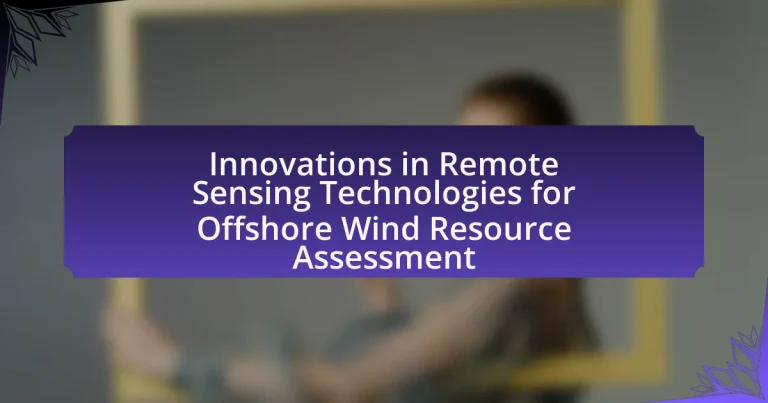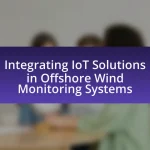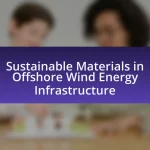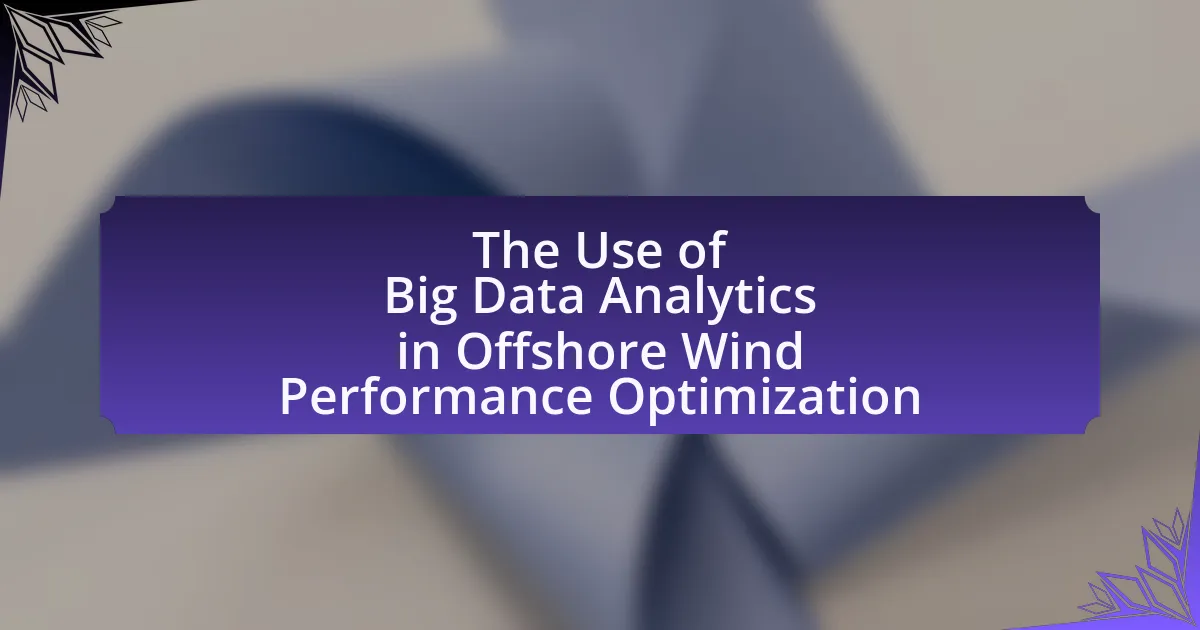Innovations in remote sensing technologies for offshore wind resource assessment focus on advanced tools such as LiDAR systems, satellite imagery, and sophisticated meteorological buoys. These technologies enhance the accuracy and efficiency of wind resource evaluations by providing real-time, high-resolution data on wind patterns and environmental conditions. The article explores how these innovations differ from traditional methods, the critical role of remote sensing in overcoming assessment challenges, and the economic advantages they offer for offshore wind projects. Additionally, it highlights emerging trends and best practices for implementing these technologies effectively in the renewable energy sector.
What are Innovations in Remote Sensing Technologies for Offshore Wind Resource Assessment?
Innovations in remote sensing technologies for offshore wind resource assessment include the use of LiDAR (Light Detection and Ranging) systems, satellite imagery, and advanced meteorological buoys. LiDAR technology enables precise measurement of wind speed and direction at various heights above the sea surface, providing critical data for wind resource evaluation. Satellite imagery enhances the ability to monitor large offshore areas, offering insights into wind patterns and environmental conditions. Additionally, advanced meteorological buoys equipped with sensors collect real-time data on atmospheric conditions, further improving the accuracy of wind resource assessments. These technologies collectively enhance the efficiency and reliability of offshore wind energy projects, supporting the transition to renewable energy sources.
How do these innovations enhance offshore wind resource assessment?
Innovations in remote sensing technologies enhance offshore wind resource assessment by providing more accurate and comprehensive data on wind patterns and environmental conditions. These advancements, such as LIDAR and satellite-based measurements, allow for real-time monitoring and high-resolution mapping of wind resources, which improves the reliability of energy production forecasts. For instance, studies have shown that LIDAR can measure wind speeds at various heights above the sea surface, capturing data that traditional anemometers may miss, thus increasing the precision of resource assessments.
What specific technologies are considered innovations in this field?
Innovations in remote sensing technologies for offshore wind resource assessment include LiDAR (Light Detection and Ranging), satellite imagery, and advanced meteorological buoys. LiDAR technology allows for precise measurement of wind speed and direction at various heights above the ocean surface, significantly improving the accuracy of wind resource assessments. Satellite imagery provides large-scale data on sea surface temperatures and wind patterns, enhancing the understanding of offshore wind potential. Advanced meteorological buoys equipped with sensors collect real-time atmospheric data, contributing to more reliable wind resource modeling. These technologies collectively enable more efficient site selection and optimization of offshore wind farms, ultimately supporting the growth of renewable energy.
How do these technologies differ from traditional methods?
Innovations in remote sensing technologies for offshore wind resource assessment differ from traditional methods primarily in their ability to provide real-time, high-resolution data. Traditional methods often rely on physical measurements from meteorological towers, which can be limited in spatial coverage and temporal frequency. In contrast, remote sensing technologies, such as LiDAR and satellite imagery, enable comprehensive monitoring over vast areas and can capture dynamic atmospheric conditions continuously. For instance, LiDAR systems can measure wind profiles at various heights above the sea surface, offering insights that ground-based measurements cannot provide. This advancement allows for more accurate assessments of wind resources, ultimately leading to better-informed decisions in offshore wind project development.
Why is remote sensing critical for offshore wind resource assessment?
Remote sensing is critical for offshore wind resource assessment because it provides accurate and comprehensive data on wind patterns, sea surface conditions, and environmental factors. This technology enables the collection of high-resolution spatial and temporal information, which is essential for evaluating potential wind farm sites. For instance, remote sensing techniques such as LiDAR and satellite imagery can measure wind speed and direction over large areas, allowing for better predictions of energy production and optimization of turbine placement. Studies have shown that using remote sensing can reduce uncertainty in wind resource estimates by up to 30%, significantly improving the feasibility and efficiency of offshore wind projects.
What challenges does offshore wind resource assessment face?
Offshore wind resource assessment faces challenges such as data accuracy, environmental variability, and high costs associated with measurement technologies. Data accuracy is critical because offshore conditions can lead to discrepancies between predicted and actual wind speeds, impacting energy yield estimates. Environmental variability, including changes in weather patterns and sea conditions, complicates the assessment process, making it difficult to obtain consistent and reliable data. Additionally, the high costs of deploying and maintaining advanced measurement technologies, such as LiDAR and floating buoys, can hinder comprehensive assessments, particularly in remote locations. These challenges necessitate ongoing innovations in remote sensing technologies to improve the reliability and efficiency of offshore wind resource assessments.
How does remote sensing address these challenges?
Remote sensing addresses challenges in offshore wind resource assessment by providing accurate and comprehensive data on wind patterns, sea surface conditions, and environmental impacts. This technology utilizes satellite imagery and aerial surveys to gather information over large areas, enabling the identification of optimal wind farm locations and the assessment of potential environmental effects. For instance, remote sensing can measure wind speed and direction at various altitudes, which is crucial for predicting energy production and ensuring the efficiency of wind turbines. Additionally, studies have shown that remote sensing can reduce the time and costs associated with traditional data collection methods, enhancing decision-making processes in offshore wind project development.
What are the key benefits of using innovative remote sensing technologies?
Innovative remote sensing technologies provide enhanced data accuracy, improved efficiency, and cost-effectiveness in offshore wind resource assessment. These technologies, such as LiDAR and satellite imagery, enable precise measurements of wind speed and direction over large areas, facilitating better site selection and resource evaluation. For instance, LiDAR systems can capture wind profiles at various heights, offering detailed insights that traditional methods may miss. Additionally, the integration of remote sensing with data analytics allows for real-time monitoring and predictive modeling, which can significantly reduce project risks and optimize energy production.
How do these benefits impact project feasibility and planning?
The benefits of innovations in remote sensing technologies significantly enhance project feasibility and planning for offshore wind resource assessment. These advancements improve data accuracy and reduce uncertainty in wind resource estimation, which are critical factors in determining the viability of offshore wind projects. For instance, enhanced remote sensing techniques can provide high-resolution wind data, allowing for more precise modeling of energy production potential. This precision leads to better financial forecasting and risk assessment, ultimately facilitating informed decision-making and investment. Additionally, the ability to gather real-time data reduces the time and costs associated with traditional assessment methods, further supporting the feasibility of projects by streamlining planning processes and minimizing delays.
What economic advantages do these technologies provide?
Innovations in remote sensing technologies for offshore wind resource assessment provide significant economic advantages by reducing costs and improving efficiency in energy production. These technologies enable precise mapping of wind resources, which leads to optimized turbine placement and enhanced energy yield. For instance, studies have shown that accurate wind resource assessments can increase energy production by up to 20%, directly impacting the profitability of offshore wind projects. Additionally, the use of advanced remote sensing reduces the need for extensive physical surveys, cutting down on operational expenses and project timelines. This efficiency not only lowers initial investment costs but also accelerates the return on investment for developers, making offshore wind projects more financially viable.
How do innovations in remote sensing technologies integrate with existing systems?
Innovations in remote sensing technologies integrate with existing systems by enhancing data collection and analysis capabilities, thereby improving decision-making processes. For instance, advancements such as LiDAR and satellite imagery provide high-resolution data that can be seamlessly incorporated into Geographic Information Systems (GIS) used for offshore wind resource assessment. These technologies allow for real-time monitoring and more accurate modeling of wind patterns, which is crucial for optimizing turbine placement and maximizing energy output. The integration is further supported by standardized data formats and APIs that facilitate interoperability between new remote sensing tools and legacy systems, ensuring that stakeholders can leverage comprehensive datasets for effective planning and management.
What role do data analytics play in enhancing remote sensing technologies?
Data analytics significantly enhance remote sensing technologies by improving data interpretation and decision-making processes. By applying advanced analytical techniques, such as machine learning and statistical modeling, remote sensing data can be processed more efficiently, leading to more accurate assessments of environmental conditions and resource availability. For instance, data analytics can identify patterns and anomalies in satellite imagery, which aids in monitoring offshore wind resources and optimizing site selection for wind farms. Studies have shown that integrating data analytics with remote sensing can increase the accuracy of wind resource assessments by up to 30%, thereby facilitating better planning and investment decisions in offshore wind energy projects.
What are the latest trends in remote sensing technologies for offshore wind assessment?
The latest trends in remote sensing technologies for offshore wind assessment include the use of Lidar (Light Detection and Ranging) systems, satellite-based remote sensing, and advanced drone technology. Lidar systems are increasingly employed for high-resolution wind profiling and mapping, providing accurate data on wind speeds and directions at various heights above the sea surface. Satellite-based remote sensing technologies, such as Synthetic Aperture Radar (SAR), enable the monitoring of ocean surface conditions and wind patterns over large areas, enhancing the understanding of wind resource potential. Additionally, drones equipped with sensors are being utilized for site surveys, allowing for efficient data collection in hard-to-reach offshore locations. These technologies collectively improve the accuracy and efficiency of offshore wind resource assessments, supporting the growth of renewable energy initiatives.
How are advancements in satellite technology influencing offshore wind assessments?
Advancements in satellite technology are significantly enhancing offshore wind assessments by providing high-resolution data on wind patterns and environmental conditions. These technologies, such as synthetic aperture radar and optical imaging, enable precise monitoring of wind speeds and directions over vast ocean areas, which is crucial for evaluating wind resource potential. For instance, the European Space Agency’s Sentinel-1 satellites deliver detailed information on sea surface conditions, allowing for improved modeling of wind behavior. This data integration leads to more accurate assessments, reducing uncertainties in site selection and optimizing the placement of wind turbines.
What emerging technologies are on the horizon for this field?
Emerging technologies on the horizon for offshore wind resource assessment include advanced satellite remote sensing, unmanned aerial vehicles (UAVs), and machine learning algorithms. Advanced satellite remote sensing offers high-resolution data for wind speed and direction, enhancing site assessment accuracy. UAVs provide flexible and cost-effective aerial surveys, enabling detailed inspections of offshore sites. Machine learning algorithms analyze vast datasets to optimize wind resource predictions and operational efficiencies. These technologies collectively improve the precision and efficiency of offshore wind assessments, supporting the growth of renewable energy initiatives.
What best practices should be followed when implementing these technologies?
When implementing innovations in remote sensing technologies for offshore wind resource assessment, best practices include ensuring data accuracy, integrating multiple data sources, and adhering to regulatory standards. Data accuracy is critical; using high-resolution satellite imagery and advanced sensors can enhance the reliability of wind resource assessments. Integrating multiple data sources, such as meteorological data and oceanographic models, provides a comprehensive understanding of wind patterns and environmental conditions. Adhering to regulatory standards ensures compliance with environmental and safety regulations, which is essential for project approval and sustainability. These practices collectively enhance the effectiveness and reliability of offshore wind resource assessments.




